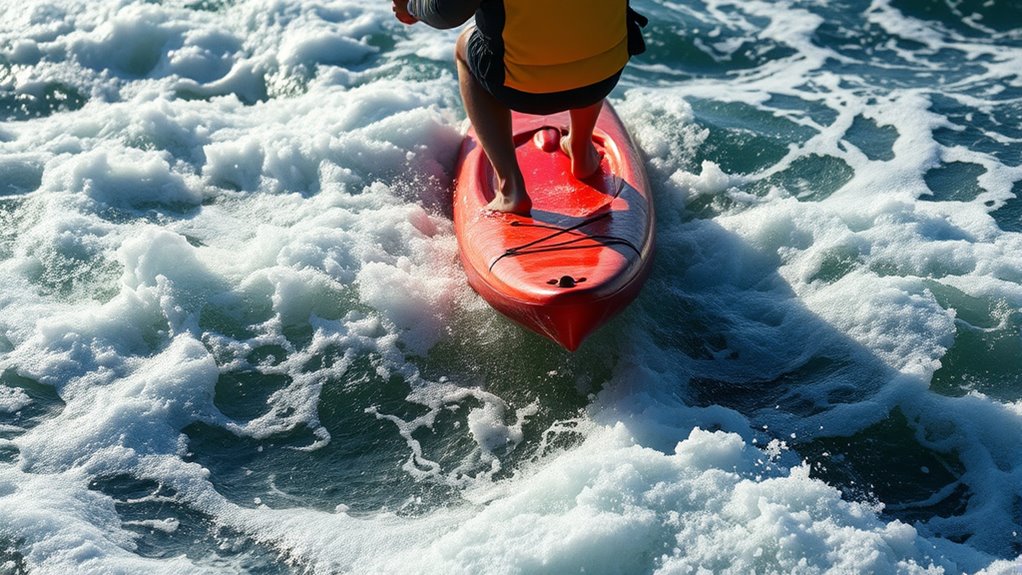To float in rougher waters, focus on steady, deep breaths to keep calm and reduce muscle tension. Lie flat on your back with your body aligned horizontally and keep your head neutral. Relax your limbs and make gentle adjustments to maintain balance against waves, using your arms to stabilize. Stay relaxed, controlling your breathing and movements, so you stay calm and buoyant. Keep practicing these techniques, and you’ll gain more confidence in turbulent waters.
Key Takeaways
- Use slow, deep breathing to stay calm and prevent panic in turbulent waters.
- Lie flat on your back with relaxed limbs, keeping your head neutral and body aligned.
- Make gentle, smooth adjustments to your body position to maintain buoyancy and stability.
- Spread your arms slightly to increase surface area and improve balance.
- Practice combining breath control and relaxed body movements to handle rough conditions confidently.

Ever wondered how to stay afloat when the waters get rough? It’s a common concern, especially when waves are crashing and you feel overwhelmed. The key lies in mastering your breath control and body positioning. These two elements work together to help you maintain stability and conserve energy, even in turbulent conditions. Once you get a grip on them, floating becomes much more manageable, giving you confidence and safety in challenging water.
First, focus on your breath control. When the water gets rough, it’s easy to panic or start breathing irregularly, which can throw off your balance. Instead, aim for slow, steady breaths. Inhale deeply through your nose, filling your lungs fully, then exhale slowly through your mouth or nose. Controlled breathing helps calm your nerves and keeps your body relaxed. When you’re relaxed, your muscles won’t tense up unnecessarily, making it easier to stay afloat. Practice this breathing pattern on calmer days so that it becomes second nature when the waters turn rough. Remember, shallow or rapid breathing burns energy faster and can lead to fatigue, so keeping your breath controlled is essential for sustained floating. Additionally, understanding how your body positioning impacts buoyancy can help you adjust more effectively in turbulent waters.
Controlling your breath keeps you calm and relaxed, making floating easier in turbulent waters.
Next, pay close attention to your body positioning. When the waters are rough, keeping a proper position can make all the difference. Start by lying flat on your back with your body aligned horizontally. Keep your head in a neutral position, looking straight up, not down at the water. This position distributes your weight evenly and helps your body stay buoyant. If waves threaten to tilt you, try to relax your limbs and spread your arms slightly outward to increase surface area, helping you stabilize. Slightly arching your back can also prevent your legs from sinking. Avoid tensing or stiffening your muscles; instead, stay loose and relaxed. This reduces drag and keeps you more buoyant, even when the water’s churning. If you need to adjust, do so gently and smoothly—jerky movements can upset your balance.
Finally, combine breath control and body positioning by staying calm and mindful of your movements. When waves crash around you, resist the urge to thrash or panic. Instead, take a deep breath, relax your body, and make small, deliberate adjustments. Keep your face up and your body aligned, using your breath to anchor you in place. Over time, with practice, you’ll find it easier to maintain this float in rougher waters. Remember, the goal isn’t just to stay afloat but to do so with ease and confidence. Master these techniques, and you’ll be better equipped to handle even the most turbulent waters safely.
Frequently Asked Questions
What Safety Equipment Should I Use When Floating in Rough Waters?
When floating in rough waters, you should always wear a life jacket or a reliable flotation device. These safety items keep you buoyant and reduce fatigue, giving you more control. Make certain your life jacket fits snugly and is approved for water safety. Carry a whistle or signaling device for emergencies, and consider wearing a helmet if conditions are particularly rough. Staying equipped guarantees your safety while floating in challenging conditions.
How Do Weather Conditions Affect Floating Techniques?
Sure, because perfect weather makes floating in rough waters a breeze, right? In reality, higher wave height and increased wind speed make floating more challenging. You need to adjust your technique, stay relaxed, and use your body to stabilize against the choppy conditions. Strong winds and tall waves demand more focus and control, so don’t rely on calm-weather tricks — adapt quickly to the changing weather to stay afloat safely.
Can Beginners Safely Attempt to Float in Turbulent Waters?
Beginners can attempt to float in turbulent waters if they conduct a proper risk assessment first. Always prioritize safety by using appropriate flotation devices, like life jackets, to reduce risks. Stay close to the shore and avoid strong currents. Keep calm, relax your body, and focus on slow, controlled breathing. If unsure of your abilities, seek guidance from experienced swimmers or lifeguards before venturing into rougher waters.
How Can I Recognize When Conditions Are Too Dangerous to Float?
You can recognize dangerous conditions by checking the water temperature and wave height. If the water feels icy or too cold, it’s risky to float because hypothermia can set in quickly. Large, choppy waves indicate rough waters, making floating dangerous and difficult to control. If you notice these signs, it’s best to wait or seek safer conditions. Always prioritize your safety before attempting to float in challenging waters.
What Are Common Mistakes to Avoid When Floating in Rough Seas?
When floating in rough seas, avoid overestimating your skills and neglecting buoyancy. Don’t panic or try to fight the waves forcefully, as that can exhaust you quickly. Keep your body relaxed, spread out your limbs to maximize buoyancy, and stay calm. Refrain from grabbing onto objects that could pull you under. Instead, focus on maintaining a steady position and conserving energy for safer conditions.
Conclusion
Mastering how to float in rough waters is like learning to ride a wild stallion—you need patience, balance, and a calm mind. Stay relaxed, keep your movements smooth, and trust your instincts. With practice, you’ll find yourself gliding like a leaf on turbulent waves, confident and in control. Remember, even the roughest seas can be navigated when you embrace the flow and stay composed. Keep at it, and you’ll surf through challenges with ease.










